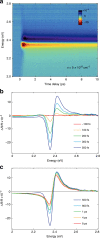Mahan excitons in room-temperature methylammonium lead bromide perovskites
- PMID: 32051405
- PMCID: PMC7016123
- DOI: 10.1038/s41467-020-14683-5
Mahan excitons in room-temperature methylammonium lead bromide perovskites
Abstract
In a seminal paper, Mahan predicted that excitonic bound states can still exist in a semiconductor at electron-hole densities above the insulator-to-metal Mott transition. However, no clear evidence for this exotic quasiparticle, dubbed Mahan exciton, exists to date at room temperature. In this work, we combine ultrafast broadband optical spectroscopy and advanced many-body calculations to reveal that organic-inorganic lead-bromide perovskites host Mahan excitons at room temperature. Persistence of the Wannier exciton peak and the enhancement of the above-bandgap absorption are observed at all achievable photoexcitation densities, well above the Mott density. This is supported by the solution of the semiconductor Bloch equations, which confirms that no sharp transition between the insulating and conductive phase occurs. Our results demonstrate the robustness of the bound states in a regime where exciton dissociation is otherwise expected, and offer promising perspectives in fundamental physics and in room-temperature applications involving high densities of charge carriers.
Conflict of interest statement
The authors declare no competing interests.
Figures




References
-
- Xiao Z, et al. Efficient perovskite light-emitting diodes featuring nanometre-sized crystallites. Nat. Photon. 2017;11:108–115. doi: 10.1038/nphoton.2016.269. - DOI
-
- Moskalenko, S. A. & Snoke, D. Bose–Einstein Condensation of Excitons and Biexcitons: and Coherent Nonlinear Optics with Excitons (Cambridge University Press, 2000).
-
- Mott N. Metal-insulator transition. Rev. Mod. Phys. 1968;40:677–683. doi: 10.1103/RevModPhys.40.677. - DOI
-
- Klingshirn, C. F. Semiconductor Optics (Springer Science & Business Media, 2012).
LinkOut - more resources
Full Text Sources

